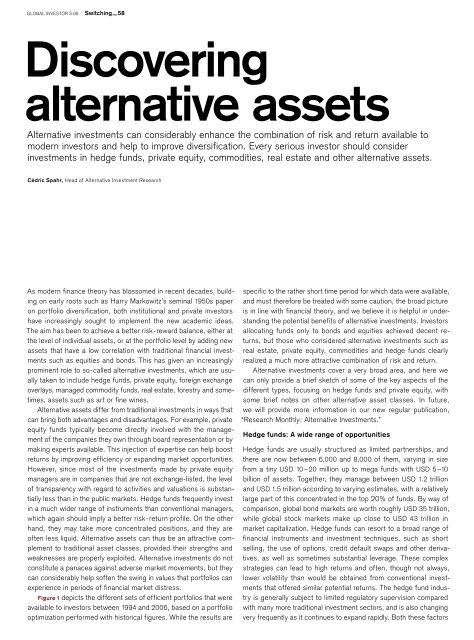Banking for 7 billion and 7 million
New challenges and opportunities of globalization Global Investor, 03/2006 Credit Suisse
New challenges and opportunities of globalization
Global Investor, 03/2006
Credit Suisse
Create successful ePaper yourself
Turn your PDF publications into a flip-book with our unique Google optimized e-Paper software.
GLOBAL INVESTOR 3.06 Switching — 58<br />
Discovering<br />
alternative assets<br />
Alternative investments can considerably enhance the combination of risk <strong>and</strong> return available to<br />
modern investors <strong>and</strong> help to improve diversification. Every serious investor should consider<br />
investments in hedge funds, private equity, commodities, real estate <strong>and</strong> other alternative assets.<br />
Cédric Spahr, Head of Alternative Investment Research<br />
As modern finance theory has blossomed in recent decades, building<br />
on early roots such as Harry Markowitz’s seminal 1950s paper<br />
on portfolio diversification, both institutional <strong>and</strong> private investors<br />
have increasingly sought to implement the new academic ideas.<br />
The aim has been to achieve a better risk-reward balance, either at<br />
the level of individual assets, or at the portfolio level by adding new<br />
assets that have a low correlation with traditional financial investments<br />
such as equities <strong>and</strong> bonds. This has given an increasingly<br />
prominent role to so-called alternative investments, which are usually<br />
taken to include hedge funds, private equity, <strong>for</strong>eign exchange<br />
overlays, managed commodity funds, real estate, <strong>for</strong>estry <strong>and</strong> sometimes,<br />
assets such as art or fine wines.<br />
Alternative assets differ from traditional investments in ways that<br />
can bring both advantages <strong>and</strong> disadvantages. For example, private<br />
equity funds typically become directly involved with the management<br />
of the companies they own through board representation or by<br />
making experts available. This injection of expertise can help boost<br />
returns by improving efficiency or exp<strong>and</strong>ing market opportunities.<br />
However, since most of the investments made by private equity<br />
managers are in companies that are not exchange-listed, the level<br />
of transparency with regard to activities <strong>and</strong> valuations is substantially<br />
less than in the public markets. Hedge funds frequently invest<br />
in a much wider range of instruments than conventional managers,<br />
which again should imply a better risk-return profile. On the other<br />
h<strong>and</strong>, they may take more concentrated positions, <strong>and</strong> they are<br />
often less liquid. Alternative assets can thus be an attractive complement<br />
to traditional asset classes, provided their strengths <strong>and</strong><br />
weaknesses are properly exploited. Alternative investments do not<br />
constitute a panacea against adverse market movements, but they<br />
can considerably help soften the swing in values that portfolios can<br />
experience in periods of financial market distress.<br />
Figure 1 depicts the different sets of efficient portfolios that were<br />
available to investors between 1994 <strong>and</strong> 2006, based on a portfolio<br />
optimization per<strong>for</strong>med with historical figures. While the results are<br />
specific to the rather short time period <strong>for</strong> which data were available,<br />
<strong>and</strong> must there<strong>for</strong>e be treated with some caution, the broad picture<br />
is in line with financial theory, <strong>and</strong> we believe it is helpful in underst<strong>and</strong>ing<br />
the potential benefits of alternative investments. Investors<br />
allocating funds only to bonds <strong>and</strong> equities achieved decent returns,<br />
but those who considered alternative investments such as<br />
real estate, private equity, commodities <strong>and</strong> hedge funds clearly<br />
realized a much more attractive combination of risk <strong>and</strong> return.<br />
Alternative investments cover a very broad area, <strong>and</strong> here we<br />
can only provide a brief sketch of some of the key aspects of the<br />
different types, focusing on hedge funds <strong>and</strong> private equity, with<br />
some brief notes on other alternative asset classes. In future,<br />
we will provide more in<strong>for</strong>mation in our new regular publication,<br />
“Research Monthly: Alternative Investments.”<br />
Hedge funds: A wide range of opportunities<br />
Hedge funds are usually structured as limited partnerships, <strong>and</strong><br />
there are now between 6,000 <strong>and</strong> 8,000 of them, varying in size<br />
from a tiny USD 10 – 20 <strong>million</strong> up to mega funds with USD 5 –10<br />
<strong>billion</strong> of assets. Together, they manage between USD 1.2 trillion<br />
<strong>and</strong> USD 1.5 trillion according to varying estimates, with a relatively<br />
large part of this concentrated in the top 20% of funds. By way of<br />
comparison, global bond markets are worth roughly USD 35 trillion,<br />
while global stock markets make up close to USD 43 trillion in<br />
market capitalization. Hedge funds can resort to a broad range of<br />
financial instruments <strong>and</strong> investment techniques, such as short<br />
selling, the use of options, credit default swaps <strong>and</strong> other derivatives,<br />
as well as sometimes substantial leverage. These complex<br />
strategies can lead to high returns <strong>and</strong> often, though not always,<br />
lower volatility than would be obtained from conventional investments<br />
that offered similar potential returns. The hedge fund industry<br />
is generally subject to limited regulatory supervision compared<br />
with many more traditional investment sectors, <strong>and</strong> is also changing<br />
very frequently as it continues to exp<strong>and</strong> rapidly. Both these factors

















